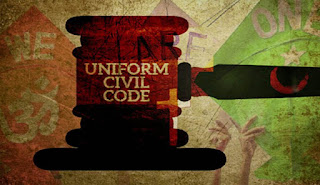1. Uniform Civil Code
Laws relating to marriage, property and heritence together is known as family laws of Goan. Hindus gad been governed by usages and customs code. For non-Christians passed in 1854 and further amended in 1880. However, in general provisions of Portuguese Uniform Civil Code 1867 were made applicable to them as well along with others to extent that.
Everyone in Goa, whether Hindus, Christian or Muslim is governed by provisions of uniform civil code passed in 1867 and later amended in 1910 by Repulican government.
Under uniform civil code, marriage considered as a legal contract with an economic bearing for after marriage. The heridatory as well as self-earned property -movable or immovable of the husband and the wife are considered as a part of the common pool and both of them have an equal share of property according to law. This is known( 'The regime of communion of Bens')
There was also provision, under which property would be treated independently if the couple had wished it that way in the pre-nuptial agreement. But this provision was hardly availed of.
Property, its's ownership and inheritence was regulated by Portuguese UCC, which was based on 'Napolean' or the 'European' continental system. In case of-one of the partners died without a will, the property is used in following manner:
One half goes to surviving factor and other half has to be shared among children in equal parts. Normally, property as stated is owned jointly by husband and the wife, regardless of who contributed how much in the common pool.
However, where it is stipulated differently in contract known as 'Anti-nuptial agreement', it is decided accordingly. In agreement, there may be a provision for complete seperation of property or in the situation of one of the partners dying without an issue(child) the property taken by wife to common fund relatives who were to look after her. There is however an exception when both of them have made a will to dispose off their properties in manner desired by them.
The law in this regard guarantees that,the inheritence due to the children remains intact and ensures that they are not dis-inherited totally for a parent, is not free to dispose off more than one-half of the disposable quota, i.e: the quota which was marked for children's benefit.
Although, the civil court in this regards prescribes complete equality between sons and daughters of a family, in practice the sons are are the heirs to all the property while the daughters are in lieu of it, and are provided with gifts and dowry at the time of her marriage. And the opinion is taken later for any claim on the parental property.
Marriage under the uniform civil code of the Portuguese regime had to be monogamous of all the communities including Christians, Hindus and Muslims. It was necessary to obtain registration with the civil registration authority before marriage in terms of religious rituals according to Hindu, Christian and Muslim tradition. Certificate of birth, domicile and vaccination from small pox and other disease had to be produced before these authorities prior to the marriage procedures at the civil registration office.
2. Etimology Of Word Goa
In acient literature, Goa was known by many names. Such as, Gomanta, Gomanchala, Gopakapattan, Gopakpuri, Goapuri, Govem and Gomantak. The Indian epic 'Mahabharata' refers to the area now known as Goa as Goparashtra or Govarashtra. Which means, nation of cowherds. Gopakpuri or Gopakapattan were used in some ancient texts and these names were also mentioned in other sacred Hindu texts, such as, Harivamsa and Skanda Purana. In Skanda purana, Goa is also as Gomanchala. 'Parshuram bhoomi' is a name that the region is referred to in certain inscriptions and texts such as puranas. In the 3rd century BCE, Goa was known as "Arpanta"
3. Parshuram Bhoomi
According to 'Parshurama Samhita', Parshurama-the sixth incarnation of Vishnu faced an order of banishment from the lands that he had once conquered-sets seven arrows fly from the Sahyadri to push back the sea and stretch the land which he could claim for himself.
The sea-god is believed to have accepted his wish and created a region 'shuparkha', which means 'winnowing fan' This region is also known as 'Parshurama kshetra'. The legend further says that, having created Goa, Parshuram brought the Gaud Saraswat Brahmins from the north, and settled them in this land. The 'Parshuram Samhita' personifies the geological process of submerged land along the west-coast.
This was all about the 'History of Goa' displayed in this blog in detail as much as possible. Hope you have gained something out of all these posts. Hope you enjoyed reading. Stay tuned for more such posts of history of India, further. Keep reading, and transform your mind into an 'Informative Mind'.


Wow
ReplyDelete